Hey look, another year’s passed, so you know the drill. Let’s look at a selection of the games I played throughout 2013 that I thought stood out from the rest.
This year, the only criterion that I’m going by is that I have to have beaten the game in question for the first time in 2013. Anything that fits into that criterion is fair game. So, for example, there are a few games that weren’t released in 2013, but that I only finally played last year.
There were just over 50 eligible titles, but I found that whittling that number down to 13 was actually very easy. The ones that I picked were just so much better than the ones I left behind. You can check out a full list of the games I beat in 2013 (including replays) here.
Okay, this intro is already running too long, so let’s just get right to business.
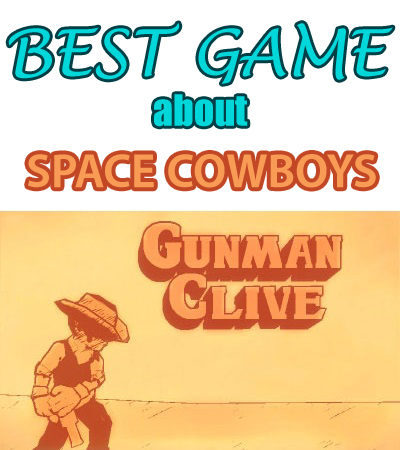
Okay, so maybe it’s not really about space cowboys, but it is about a cowboy and he does go to space. Also, I needed an interesting and brief description for the title. That’s the best I can do. And Gunman Clive is the best that you can do if you’re looking for a cheap 3DS platformer. It’s on iOS too, but if you’re playing platformers on your iDevice, you’re doing it wrong.
Gunman Clive is an exceptionally competent little game, and the designers were clearly paying attention to the best platformers of old when they made it. Bearing a striking resemblance to what a certain little metal boy’s run-and-gun adventures, Gunman Clive is packed to the gills with platforming action, exciting shootouts, and tense boss fights. And if you’re good, you can clear it in a single sitting, which I absolutely put in the Pro column for this kind of game.
You’re going into this one for the top-notch gameplay, but the little things that make it stand out are definitely worthy of praise on their own. The stylistic graphics are really very nice, and look just like what I imagine a sepia-toned, animated sketchbook would look like. You’re also given the choice at the beginning to swap around the usual gender roles and play as Ms Johnson, who would normally be the damsel in distress. There’s also an unlockable Duck Mode, which lets you play as -you guessed it- a duck with no offensive capabilities. It’s pretty great.
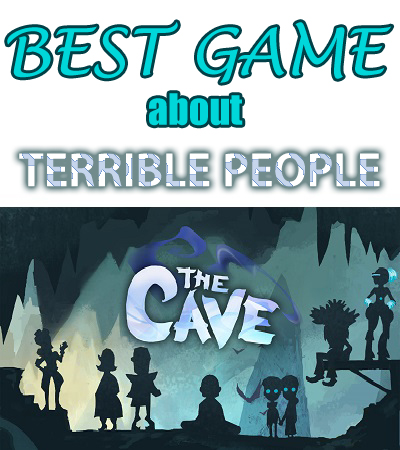
The Cave was released on pretty much everything early in 2013 (the iOS version came out in October), and being a Double Fine game, I was eagerly anticipating its release. It also helped a lot that people were billing it as a metroidvania written by Ron Gilbert (of Monkey Island fame). In the end, it wasn’t actually a Metroidvania, but there’s so much more there to love that I didn’t even care.
The game is about a team of adventurers who go into a mysterious cave for unclear reasons. You get to choose three of seven characters for your journey, and each has a horrible backstory which is not only reflected in artwork that you collect along the way, but also as the plot behind each character’s unique stage. Along the way, the narrator (who is the cave itself) will crack wise and taunt the adventurers. The narrator’s script is fantastic and his delivery is spot on, and I honestly think that his narration is reason enough to play the game.
You won’t be doing a whole lot of playing, however. The game is a puzzle-platformer, but the puzzles are generally quite easy, most of them being either of the “find the correct thing to use here” or “have one guy stand on the switch so another guy can pass” variety. Nothing that will stump you for more than a minute. But unlike Gunman Clive, the strength of The Cave is not in gameplay, but entirely in its plot and characters, and finding out what heinous thing each of the characters did (and if/how they redeem themselves) is a great reward in its own right.
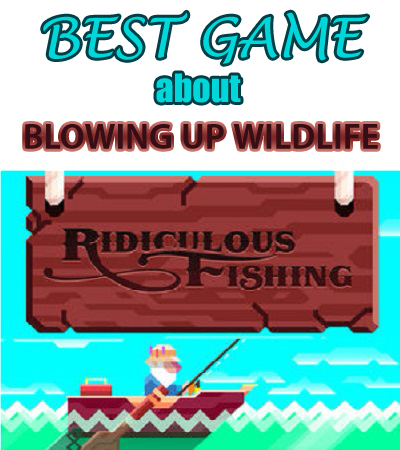
It’s not very often that I’m overly impressed with an iOS game. Heck, it’s not even very often that I keep a game on my phone for longer than a week or so. The only reason most of them stick around is because I have a deep-rooted need to collect experience points in as many ways as possible. Even the ones I do like are usually hampered by terrible, terrible touch screen controls.
Ridiculous Fishing is different though. It might be the first mobile game that I’ve truly enjoyed on its own merits. The game has a simple premise: hook as many fish as possible and then blow them to smithereens. How does this work? Once you cast your line, the hook sinks down, and you tilt your device side to side to steer it around the various water-based wildlife. When you do hit one, the line starts heading back up to the surface, and you have to try to snag as many more fish as possible on the way back up. Then they all get flung into the air and you tap the screen to shoot them into bloody little giblets. It’s totally ridiculous, and totally fun.
Blasting fish will earn you cash and fill up your fishopedia (that’s what they actually call it, and I love it), which will allow you to buy supplies and unlock new fishing locales respectively. There are plenty of upgrades to buy, from longer fishing lines, to a chainsaw lure that slices through fish on the way down, to a satellite laser beam. Best of all, once you pay your $3 to download the game, that’s all the money is asks from you. There are zero microtransactions, meaning that you can experience everything that Ridiculous Fishing has to offer without having to open your wallet again. Beautiful.
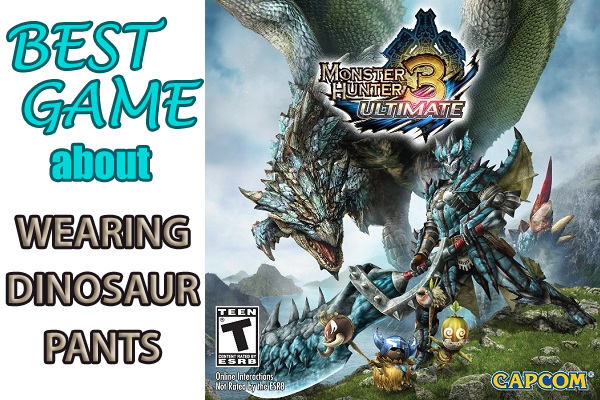
Let’s not waste any time here: I love Monster Hunter. I have loved Monster Hunter for years. And I will continue to love Monster Hunter for the foreseeable future. This particular edition is an upgrade of 2010’s Monster Hunter Tri, but Capcom added so much content that it may as well classify as a new game. Also I never actually finished Tri, so there’s that too.
If you’ve never read anything I’ve written about the MH series before, here’s a primer: You’re a fellow (or lady) with a big ol’ weapon, and your job is to hunt big ol’ monsters. This is not as easy as it would be in most video games, and if you’re not 100% prepared for the fights ahead, you’ll likely have your head handed to you very quickly. Learning the ins an outs of the game is half as fun as actually engaging in combat against the giant monsters.
What really sells the series, however, is the multiplayer. While tackling the game solo is absolutely possible, it’s a lot more fun to hop online and join up with a few other hunters. The teamwork aspect isn’t terribly deep, but at the least, it’s super convenient to have one player distracting a beast while the other gets a few hits in. MH3U is even better because it allows for offline muliplayer, thanks to the ability to link the 3DS and Wii U versions. That and it’s just really nice to have Monster Hunter on the go (and not have to cart my PSP around).
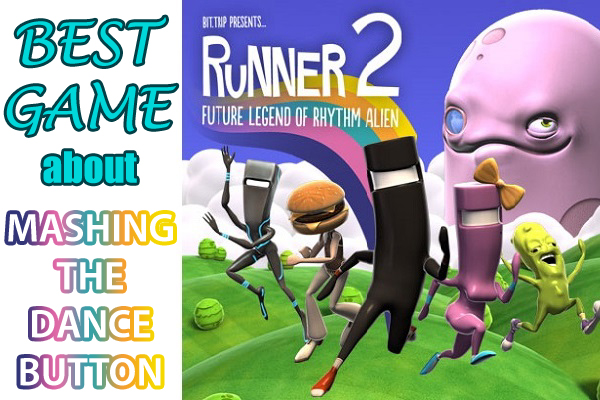
For whatever reason (mobile devices’ poor touch controls), runner game seem to have gotten incredibly common over the past few years. Many of them are utter garbage, and pretty much all of them are the same damn thing with a different theme. Or the same damn thing with the same damn theme but a slightly different name. Thank goodness for Gaijin Games.
Runner2 is the absolute best runner for many reasons. First of all, it’s not an endless high-score challenge. Those are fun for a while, but lose their lustre pretty quickly. Runner2 is chopped up into 120 levels over 5 worlds. This allows for a sense of progression and completion than endless runners lack. So basically, a concrete reason to keep playing. Other runner games tend to enjoy making you buy power-ups with real money. Runner2 has no power-ups or microtransactions. You’ll note that a lack of in-game purchases is always a pro to me.
The big thing that separates Runner2 from the wannabes is that it isn’t just a test to see how long you can react with the jump or duck button, but rather it operates on a certain rhythm. It also provides many, many ways to interact with stages, going outside the usual jump/duck combo with kicks, loop-de-loops, blocks, and the ever-lovable dance. If you’re looking to place on the game’s leaderboards, the dance button will be your best friend. Pressing the dance button makes your character do a second-long dance move, and scores you some points. It’s at that point where the game becomes not about dodging the obstacles, but finding out the best place to fit dancing in between said obstacles.
It really adds a whole extra layer onto an already robust game. With three difficulty levels, hidden stages, unlockable characters and costumes, and in-game achievements, there’s a ton of content in Runner2. And let’s not forget the most important part: the amazing soundtrack. It’s on iTunes. Oh and also Charles Martinet narrates the game. Wonderfully.
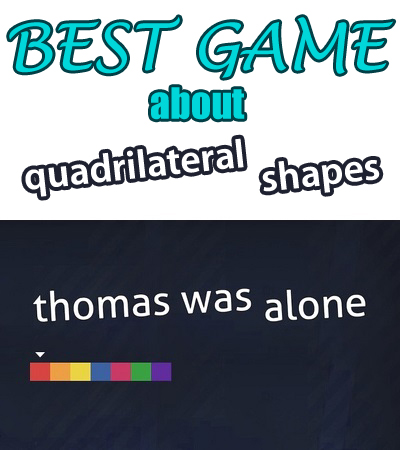
Thomas Was Alone was like many indie games before it: something I’d heard buzz about, but really didn’t care enough to actually see what the big deal was. Then I got it by chance in a Humble Bundle, and ended up playing through the entire thing one morning.
The game is not very long, but I felt like pretty much every moment I spent with it was more engaging than a lot of games that I get in Humble Bundles. The premise is very basic: you have a little red square (Thomas) that can only jump, and you have to guide it to the exit. After so many levels, a new coloured shape is introduced with a slight jump variation, and you eventually have a big crew of quadrilaterals that you have to get through each stage.
Fact of the matter is though, that even when you’ve got to navigate six or seven of the blocks to the end, none of the puzzles are terribly difficult. What really sells the game is the narration. Yeah, sure, that’s what a lot of silly indie games sell themselves on these days, but I really enjoyed Thomas Was Alone’s take on it. Each quadrilateral has a name and personality, and even though it’s one narrator speaking all of their thoughts, I still ended us seeing the blocks as actual characters rather than just coloured bricks. It’s a very charming, funny, and sometimes heartrending game.
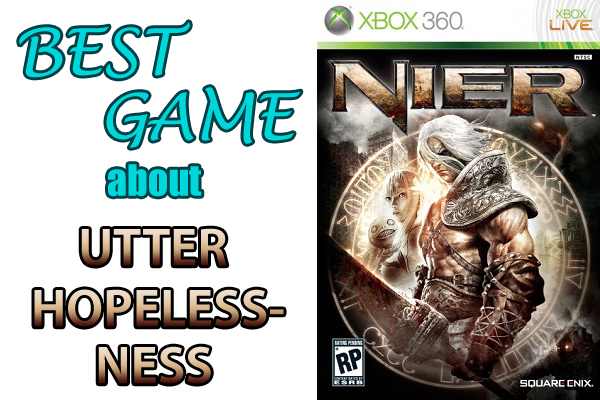
This list of best games isn’t numbered on purpose. I didn’t want to assign values to these games, because I loved each one of them for very different reasons. If I had to choose one standout as my game of the year though, I think I’d have to give it to NIER, despite the fact that the game was released back in 2010. I’ve already written at length about why I like NIER so much, so let’s take a look at what defines the title I awarded it.
The overall plot of the game is to guide Nier in his quest to save his daughter, Yonah, who has contracted an incurable disease. The first half of the game consists of finding a selection of ancient magic that may or may not have the power to cure the disease. Unfortunately, all it ends up doing is drawing the attention of the Shadowlord, who promptly abducts Yonah and disappears for five years. The second half of the game is collecting the keys to the Shadowlord’s tower, and at the end, it turns out that he just wanted Yonah as a vessel to revive his own daughter. This second Yonah decides to give up her life so that Nier’s Yonah can live, which sends the Shadowlord into a rage, and you then kill him dead. Even as a brief summary, that’s pretty bleak.
It gets so much worse when you play the game a second time, though. New Game+ only makes you play the second half of the game again, but it’s filled up with a bunch of extra cutscenes, and each one will break your heart even more than the last. What these cutscenes are, are insights into who the bosses are, and what their motivations are. Turns out that they’re just protecting their friends and families, and the grim reality of it all is that every Shade (enemy) in the game is actually a human being. Nevermind the fact that once you read up on the entire backstory of the game, you realize that killing the Shadowlord is effectively starting the extinction of the human race. There are spoilers in this summary, but that spoiler is so big, that I just had to hide it.
In the end, I don’t think that there is a single other video game that made me have quite as many feels as NIER did, and I absolutely love it for that. I’ll grant you that the vast majority of them are not good feels, but it’s still not very often that you really care about characters in your video games. If you don’t cry when a certain character sacrifices himself, or hesitate to kill Beepy and Kalil on your second time around, you are either a sociopath or a heartless robot (quite the opposite of Beepy).
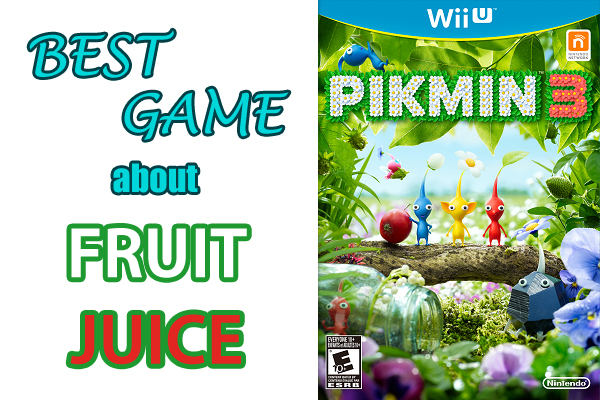
Unlike NIER, Pikmin is utterly adorable and charming on the surface. Of course, if you think about it too hard, it’s pretty horrifying in its own right, but let’s not go down that rabbit hole today. No, let’s just talk about how much fun it is to run around collecting fruit with an army of cuddly little plant people.
Spoiler: it’s very fun! But also it can be a little stressful too, because it is emotionally crippling when you see any of your Pikmin die. But mostly it’s fun, and if you’re really good, you don’t have to worry about watching your Pikmin die. And let’s get this out of the way right now: I’m not quite that good at Pikimin. Throughout my journey through the campaign, I led several hundred of the little guys to their deaths, and I find it terribly difficult to resist building tiny memorials to each and every one of them. They fought and died for me; the least I could do is honor their memory. I’m really going off on a tangent here.
Pikmin 3 is superb. It would be the Best Wii U Game if it weren’t for that gosh-darned Mario guy and his 3D World, but second place isn’t too bad. It lacks the semi-random dungeons of Pikmin 2, and that’s both good and bad. On one hand, the dungeons were a fun twist to the first game’s formula. On the other hand, they got a little long in the tooth by the time the game was nearing it’s end. No, Pikmin 3 simplifies things by making the entire game take place in the overworld, and that’s just fine. But really, the story mode is just a warm up for the real meat of the game: mission mode.
The thing that sets Pikmin 3 apart from every other Nintendo game ever is that Nintendo keeps supporting it by releasing new DLC levels for mission mode, and by gum, they’re a lot of fun to play, especially with a second player. Mission mode is pretty simple, it’s either a race to kill all the enemies or collect all the fruits before the timer runs out. But these stages can be devious, and you’ve got to have skills to just beat them. If you’re looking for a platinum medal or a place on the online leaderboards, you really have to become one with the game. Truly, mission mode takes the Pikmin experience to a whole new level.
If I have one gripe about the game though, it’s that the only thing you ever collect is fruit. Gone is Pikmin 2’s wonderment of what wacky treasure you’re going to find next. A fairly insignificant gripe, but one I wanted to share no less.
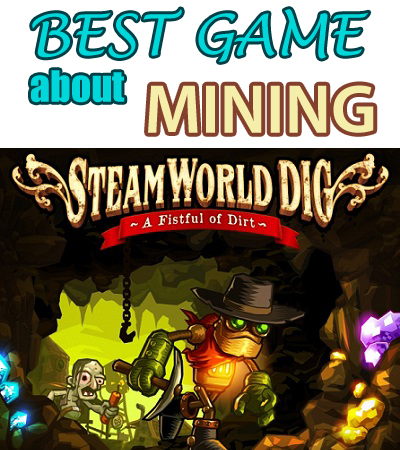
Let’s face it, we live in a world where we’ve been trained to at least perk up our ears a little bit whenever we hear something about a game with the words “mine” and/or “craft” in the title. Steamworld Dig doesn’t have either of those in its title, but it does have the word “Dig,” and that’s close enough to have gotten my attention. Oh, and also all the heaping praise it was getting before and after its release on the 3DS eShop.
Needless to say, peer pressure worked its magic and I downloaded the game as soon as I could. Fortune smiled upon me, and I was not disappointed. Steamworld Dig is, like many others, a side-scrolling mine-em-up game. Which basically means that you dig down and pick up minerals until your light runs out, at which point you return to the surface and sell those minerals. Then you buy some upgrades that let you mine longer/more efficiently, and the cycle begins anew.
Steamworld Dig, however, has a few things that no other game of this type (that I’ve played) has: 1. a plot and 2. and ending. No, it’s not the most compelling plot, but at least you’re not just digging for the sake of digging. The ending is nice too, because I like games with a goal to work towards. It’s also got 3. a bunch of preset puzzle rooms within the main shaft, many of which award new character power-ups, like wall-jumps, double-jumps, and a charge shot, effectively sitting Steamworld Dig under the Metroidvania umbrella. And you just know how I feel about Metroidvanias. Also 4. you play as a Cowboy Robot.
In conclusion, if you’re interested in these dig-em-ups, but can’t help feeling “why bother?” by their endless, cyclical gameplay, Steamworld Dig might be exactly the thing you’re looking for. I know it was exactly the thing I was looking for. There’s also an HD version on Steam now so, you know, no excuses.
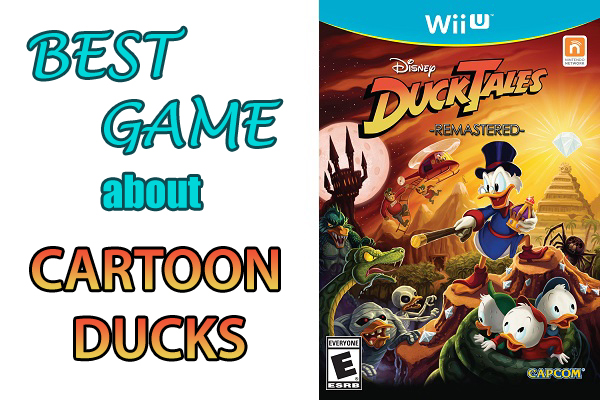
If you’re reading this, you’re already well aware of the reputation that DuckTales on the NES has. If for some reason you don’t know, it’s great. People far and wide praise DuckTales as a true NES classic. I never played it though. I read about it in Nintendo Power, sure, but I really had no idea what the big deal was. And then I played the HD remake.
Just like NIER, I’ve already done this song and dance, and I really don’t think I have anything to add to my previous review. But if you don’t want to read that whole thing, here’s the highlight reel:
- Holy crap, that music
- Tough-as-nails NES difficulty…
- …but also a really easy Easy Mode for crybabies
- Great cutscenes with original voice actors
- Pogo funtimes!
- Beautiful Wayforward-brand sprites
- Swimming in the money bin
- Did I mention how good the music is?
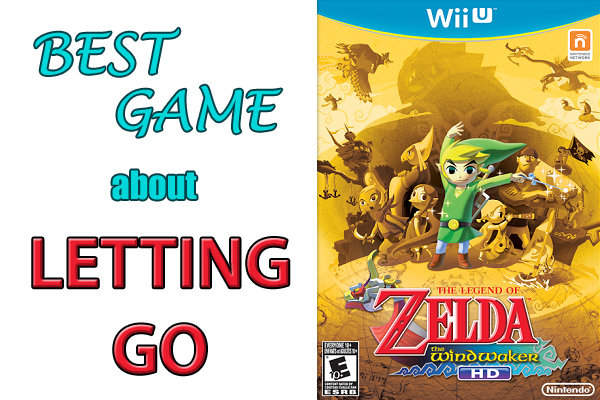
You played The Wind Waker on GameCube, right? No? Why not? It’s a fantastic game! Oh, the sailing was a turn off? And the Triforce quest was drawn out and boring? And you wish you could have a sea chart open at all times? Good news! I’ve got just the thing for you!
Yes, The Wind Waker HD rectifies all of these problems and more! Now you can find a Swift Sail that makes travelling the GreatSea a breeze! Now a huge percentage of the padding has been removed from the Triforce quest! Now the sea chart is always open on the Gamepad screen so that you don’t have to pause to see where you’re going or where the nearest spot-marking X is! Also, light bloom like crazy! Well, that last one isn’t so important, but it’s pretty.
What I really want to note here though, is something that sort of passed me by when I played the original version of this game: the story. Or more precisely, the ending. It’s may be all cheery and stuff, but it’s actually pretty sad. The secret is that the story isn’t really about Link or Tetra, but rather, it’s about two tired old men and their centuries-old power struggle. The King of Hyrule and Ganondorf are both obsessed with the kingdom of Hyrule: one with making sure that it endures forever, and the other with claiming it for himself. In the end, one man refuses to let go of his obsession, and he dies by having a sword stuck through his head and being petrified at the bottom of the sea. The other man decides that it’s time to let go, and dies happily, knowing that though his time and his kingdom have come to an end, that he has set a new generation on the path to building a new, better world. It’s sad, pitiable, and touching all at the same time, and it’s a damn shame that the depth of it went completely over my head before.

Over the years, each new set of Pokémon games sticks fairly rigidly to the formula, opting not to revolutionize the series, but to simply improve it by making a few small tweaks here and there. Pokémon X and Y made many more changes than usual, some of them bigger than ever before, but still remains basically the same at its core.
Some of the bigger changes include Mega Evolutions and new battle types, but the one that you’re going to notice right away, the one that you’re going to appreciate for your entire stay in the Kalos region, is the change from sprites to 3D graphics. Of course, the overworld has been in 3D for a couple generations now, but with X and Y, sprites are gone completely. And it is a beautiful thing indeed. The most notable improvement is in the battles, where the polygonal Pokémon really come to life. I know that the 3DS is capable of some fairly nice graphics, but I swear that every time that I boot up the game I am awed by how good the Pokémon models look.
Another big change is that Game Freak has finally decided to let us adjust the look of our avatars. The choice of skin and hair colour at the beginning of the game is just the tip of the iceberg. There are fashion boutiques throughout the game that let you buy new clothes for your trainer, and I’ll freely admit that I probably had just as much fun dressing up my girl as I did battling with my Pokémon. To be entirely honest, for a while I was changing her outfit every day. The hair salon is also a lovely little touch, but it’s also kind of disappointing, because you can’t outright choose the hairstyle you want. Instead the game makes you answer a couple general questions, and if you don’t like the result, you’ve got to pay for another styling. Haircuts don’t come cheap, either!
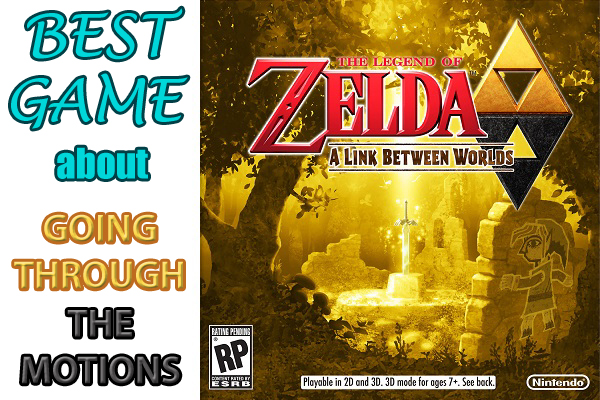
A Link Between Worlds is officially the sequel (well, the other sequel) to A Link to the Past. That much is obvious, and has been explicitly stated by Nintendo many times. What they don’t really mention, is that it’s almost more of a second quest than a sequel. Sure, the story is different, but a lot of the game is actually very similar. Least of all, the entire structure of the game being exactly the same as its forebear.
The Hyrule map is pretty much a pixel-for-pixel recreation of the Hyrule from A Link to the Past, of course with a few minor changes here and there (like now being made of polygons). The dungeons are new, but that’s what the whole second quest business is all about, right? The second world, Lorule, is also fairly new, but does hit a lot of the same beats as the Dark World did. The dungeons are all in the exact same places, but of course, their interiors are entirely different, and they’re designed so that you can play through them in any order that you choose.
The juxtaposition of the well-known with the totally new works so well in this game’s favour. It’s more than bringing over a few character models from the last game; you really feel like you’re getting to explore the same world after a few generations have passed. The new content is absolutely perfect too. The dungeons are without a doubt the best that Zelda has ever had, and the wall-merging mechanic that so many puzzles hinge on is brilliant beyond words. I was so impressed after my first play through the game that I immediately went back and played it a second time on Hero Mode, and it’s exceptionally rare that I’ll play a game to completion twice in a row.
NIER might be my game of the year for the excellent package surrounding the gameplay, but if you want my bid for game of the year based on straight-up gameplay, A Link Between Worlds is the clear frontrunner. More than that, I’m willing to say that it’s the Best Zelda Game, and it might even be strong enough to break through the dense barrier of nostalgia that surrounds Link’s Awakening and become my favourite Zelda game. I’m not quite ready to make such a bold proclamation, but that’s mostly because I’m afraid of change. 2013 has been a banner year for 3DS, and as a perfect cap to such a great year, A Link Between Worlds is good enough to warrant owning a 3DS for it alone.
